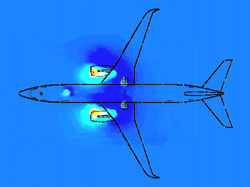Project Success Stories - Magnetic sensors for smarter airfield surveillance
Bad weather, poor airfield design, human error and outdated or ineffective ground radar systems can lead to accidents and deaths. One indicator of airport safety problems is the number of near misses between planes, and between planes and ground vehicles ― runway incursions. In 2008, the number of runway incursions at airports under the US Federal Aviation Administration (FAA)'s watch hit a record high of 1009. Last year, saw a slight drop (951 incursions) which now looks like being reversed with nearly 900 incursions already recorded in the first nine months of 2010. With air traffic set to continue increasing for the foreseeable future, something needs to be done to improve airfield surveillance before a major accident happens. This was the overriding rationale of the Ismael research consortium, led by the University of Saarland in Germany, which focused on delivering 'Intelligent surveillance and management functions for airfield applications based on low-cost magnetic field detectors'. By monitoring tiny fluctuations in the earth's magnetic field caused by a moving object, like a plane or refuelling truck, Ismael developed an innovative system to increase airport safety even in the worst weather conditions and where other monitoring systems struggle. Ismael's detector system is designed for use within so-called advanced surface movement guidance and control systems (A-SMGCS). It can improve existing A-SMGCS installations at large airports, but the simple ingenuity of the system means it is suited to smaller airports which usually can't afford complex installations and systems. The novel approach, tested at three airports in Germany and Greece, relies on an array of small, cheap sensors monitoring the so-called 'magnetic fingerprint' of planes ― the slight influence the aircraft's metallic body has on earth's magnetic field. The technology provides information on the type of vehicle/aircraft and its position, speed and direction. As such, it stands to improve the overall 'situational awareness' in air traffic control, helping airport operators meet future traffic demands while minimising delays and service delivery costs to acceptable levels. Saving lives and more Saving lives is the central goal of the safety improvements investigated by Ismael. But the team is also keen to point out the significant economic benefits of their system. For example, by being able to pinpoint the exact location and course of an aircraft or vehicle, airports would be able to keep throughput levels at capacity even during periods of bad visibility. Ismael's system also boasts several technological plus points. The small size of their sensors and their modular design means they can be installed quickly and relatively easily in almost any location, they require less energy to power them, and they are easy to maintain and upgrade. Ismael's system uses 'passive detection', so needs no secondary transponders placed somewhere on the vehicles being monitored. The technology doesn't rely on radio waves so there is no interference with other systems like aircraft radio. What's more, 'the sensor is completely unaffected by buildings, other aircraft, road traffic or anything else that can interrupt the line of sight of existing equipment', note the researchers. Reliable, viable Since ending the EU-supported part of its work in 2007, Ismael partners have kept the three test sites running to gather important data on the reliability of their system. In the meantime, other airports and companies have expressed interest in trying Ismael's sensors, says the project's co-coordinator, Uwe Hartmann. 'Also, I recently hosted two visitors from the MITRE corporation ― a US public consultancy used by the FAA. MITRE is doing a study on "remote tower technologies" and Ismael will definitely be recommended as the most suitable technological improvement for small- and medium-sized airports,' he tells CORDIS News. In the test sites in Frankfurt and Thessaloniki, the information generated by Ismael's sensor installations has now been combined with other data sources like radar, flight data and transponder signals. While the technical capabilities of Ismael's system have been fully demonstrated, more effort is needed to establish its operational credentials on the market, suggests Mr Hartmann. Introducing novel technologies into airports takes time and patience, he suggests, which is why he and his colleagues take every opportunity to get the word out about Ismael to relevant organisations and authorities. 'The process seems to be slower than in other technological areas, presumably mainly because of the considerable safety requirements,' he stresses. 'Presently, we are much closer to establishing the Ismael technology in the US than in Europe.' Ismael was funded under the 'Information society technologies' (IST) strand of the Sixth Framework Programme (FP6) for research.

